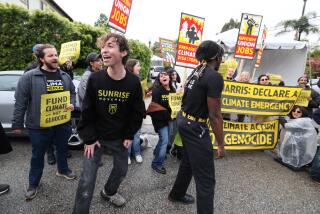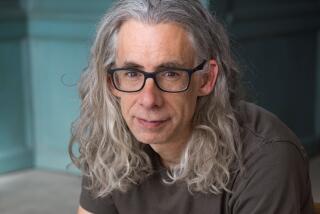Review: ‘Shadowlands’ goes inside ‘one whacked-out American story’
The 2016 armed takeover of an Oregon bird sanctuary by antigovernment protesters had a bit of everything: impassioned talk of freedom and “We the People” democracy, right-wing Mormon cowboys on a divine quest to help ranchers who didn’t want it, live-streamed updates by the occupiers and FBI video of a fatal police shooting that hastened the end of the bizarre 41-day episode.
“No doubt about it: this was one whacked-out American story,” Anthony McCann writes in “Shadowlands: Fear and Freedom at the Oregon Standoff,” his colorful, insightful, sometimes poetic, occasionally ponderous account.
The setting is Harney County, a huge, middle-of-nowhere chunk of Southeastern Oregon, mostly high desert ranch country, 300 miles and a world away from Portland.
Roughly the size of Massachusetts, the county has just 7,000 or so two-legged inhabitants and many times more cattle. They roam a vast and beautiful and desolate landscape, and McCann, a California poet, creative writing instructor and Mojave Desert dweller, captures the region’s wide open feel.
“There’s a special, thrilling kind of loneliness to the place … there’s such a tone of vanishment to the Harney Basin, of things present and absent all at once,” McCann writes. “Folks say people come to Harney County to disappear — it’s not hard to understand why.”
Ammon Bundy and his open-carry firearms contingent had come here in late 2015 not to disappear but to show their support for father and son ranchers Dwight and Steven Hammond, who had run afoul of the law by setting fire to public lands. The Hammonds were headed back to prison after a federal judge ruled they’d been let out too soon after their convictions and had to finish mandatory five-year sentences.
Bundy is the son of Cliven Bundy, a Nevada rancher who clashed in 2014 with the U.S. government by denouncing its legitimacy and refusing to pay federal grazing fees. The dispute sparked national headlines when the Bundys successfully resisted — for the time being, anyway — attempts by authorities to seize their cattle as payment.
Ammon had emerged from that standoff as a social media star to such like-minded Americans as militias, patriots and sovereign citizens groups. They generally shared a belief that the federal government lacked the authority to own or govern public lands, citing justifications from pocket-sized versions of the Constitution. Claiming to be guided by a divine hand and toting sidearms and rifles, the devout Mormon and his followers had ridden to the rescue of the Hammonds — who, it turned out, wanted little to do with them. Few in Harney County did.
Rebuffed by the Hammonds and most of the locals, Bundy rang in the New Year by leading an armed party in a takeover of the headquarters of the Malheur National Wildlife Refuge on Jan. 2, 2016, some 30 miles from Burns, the county seat. The stated goal was to return the land to its “rightful owners,” although Bundy’s newly dubbed Citizens for Constitutional Freedom seemed all but blind to the fact that the original landholders were not the white ranchers they had in mind but rather members of the Burns Paiute Tribe and their Northern Paiute Indian forbears.
“We weren’t removed. We were killed and ran off our land. Marched in the snow out there, hundreds of miles,” a tribal member told the author, recounting the tribe’s history and rejecting the Bundy group’s later efforts to enlist its support. “They just need to get the hell out of here.”
Bundy and the others hung out at the refuge for more than three weeks, as the feds assumed a “wait them out” posture. That ended when he and some of his followers ventured from the compound on Jan. 26 and their vehicles were intercepted by the FBI and state troopers.
Bundy and others surrendered, but one of his followers resisted. Robert “LaVoy” Finicum, who had served as a spokesman for the takeover, was gunned down in the snow by state troopers when, according to authorities, he reached for a handgun in his coat. He was the only casualty of the conflict, which ended Feb. 11 with the arrest of the last of the occupiers.
At turns empathetic and sarcastic, McCann seems adept at sizing up Bundy and his followers, and he freely dishes out criticism of the federal government and its policies.
The book dives deep into the history of the Bundy clan and the Patriot movement, the Church of Latter Day Saints and the American West and its geography and colorful characters, including some on the fringes of the takeover. Readers meet a guy who showed up dressed as George Washington, mingled with the occupiers for a while and left, and an FBI informant named Fabio Minoggio, who posed as a firearms expert and infiltrated the group under the alias John Killman — Really? Killman? There’s also a stuttering defense attorney who wound up getting tackled and stun gunned by U.S. marshals in the courtroom where his client, Bundy, was just acquitted of charges in the Malheur standoff.
Like the man said, this was one whacked-out American story but one well worth reading. McCann not only backlights the setting and the characters with historical detail that fleshes out the 2016 episode but also puts the story in the context of a politically tumultuous year that landed Donald Trump in the White House.
Last year, in a move celebrated by the antigovernment types, Trump pardoned the Hammonds, the ranchers who inspired the takeover.
Shadowland: Fear and Freedom at the Oregon Standoff
Anthony McCann
Bloomsbury: 442 pages; $30
Christensen is a Pulitzer Prize-winning investigative reporter at The Times.
More to Read
Sign up for our Book Club newsletter
Get the latest news, events and more from the Los Angeles Times Book Club, and help us get L.A. reading and talking.
You may occasionally receive promotional content from the Los Angeles Times.







